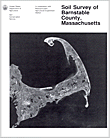The following is a map unit description from the "Soil Survey of Barnstable County, Massachusetts (Fletcher, 1993)"

Fs-Freetown and Swansea mucks, 0 to 1 percent slopes. These very deep, level, very poorly drained soils are on outwash plains and moraines and in areas of glacial lake deposits. They are in depressions and in areas adjacent to streams, ponds, and lakes. They make up about 1.4 percent (3,537 acres) of the survey area. They are mapped throughout the county. Areas are irregular in shape and range from 3 to 200 acres in size. They consist of Freetown soil, Swansea soil, or both. These soils were not separated in mapping because no major differences affect their use and management.
Typically, the Freetown soil has a surface layer of dark reddish brown mucky peat about 2 inches thick. Below this to a depth of 65 inches or more are alternating layers of dark reddish brown and very dusky red muck and mucky peat.
Typically, the surface layer of the Swansea soil is black muck about 2 inches thick. Below this is very dark gray and black muck about 26 inches thick. The substratum extends to a depth of 65 inches or more. The upper part is 3 inches of dark yellowish brown, very friable loamy sand and 8 inches of black muck. The next 8 inches is very dark grayish brown, friable loamy sand. The lower part is 18 inches of dark yellowish brown, very friable loamy sand.
Included with these soils in mapping are areas of Berryland, Maybid, and Pipestone soils. These included soils make up about 10 percent of this unit.
Most areas are wooded or support shrubby vegetation. These soils are unsuited to cultivated crops, hay, and pasture because of the seasonal high water table. Draining the soil is difficult because suitable outlets are not readily available and cannot be maintained.
These soils are poorly suited to woodland because of the wetness, a high seedling mortality rate, and a hazard of windthrow. Optimum growth and survival of seedlings are not expected. Because of low soil strength, equipment use should be limited to periods when the soils are frozen. The most common trees are red maple, tupelo, and Atlantic white cedar.
These soils are generally unsuitable for most nonfarm uses because of the wetness and low strength in the organic material. Alternative sites should be selected.
These soils are well suited to wetland wildlife habitat. The common native plant communities provide adequate food and cover for nesting areas.